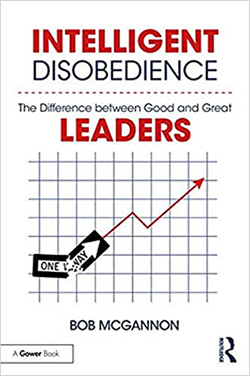We kick off this episode as Frankly IT with Bob McGannon. He spent 20 years at IBM. He’s now a management consultant, coach, and the author of Intelligent Disobedience: The Difference Between Good and Great Leaders.
Listen here
Why Great Leaders Teach Their Teams to Break the Rules: Interview With Bob McGannon

[02:25] Intelligent disobedience comes from the world of seeing eye dogs. The dogs are trained for 12 to 18 months to obey and then trained for 12 to 18 months to know when not to obey to protect themselves and their master. In business leadership, the same skill is needed.
[03:21] Bob talks about how leaders can engage in intelligent disobedience to get the best outcome.
[04:06] It’s not only about knowing when you can get a better outcome by not following the rules and processes but also understanding the context and boundaries.
[04:30] It’s not about personal gain. It’s about business outcomes. Bob also doesn’t support lying or passive aggressive behavior where you agree to a process and then don’t follow it.

[06:00] Giving people permission and space to break the rules is part of the equation. You can also teach by reinforcing the outcomes you’re looking for.
[07:39] Describing someone’s role and telling them whether to focus on the process or the outcome can make a difference as to whether they apply intelligent disobedience.
[08:13] IT environments need a defined architecture that you stick to. But there will be times when you need to evolve and change the rules.
[10:08] An example of this is police following the interest of the law as opposed to giving tickets for going one mile over the speed limit.
[11:21] It’s about doing something different in a business to get a better outcome.
[13:19] There are two pieces to this concept. A person needs to identify that the rules aren’t going to work in a given situation and that they can go outside the rules and not get in trouble.
[15:28] To get started, a manager needs to assess the character of their people. People have to have the right character in order to do this.
[17:10] They also need to balance the risk of breaking the rules and long and short-term outcomes. There are four levels of intelligent disobedience in Bob’s book.
[19:14] Enabling employees to solve issues as long as it does no harm and doesn’t break laws can make the team more efficient. Managers still need to be notified, after the fact.
[24:08] Enabling employees also improves morale. It can be a great retention strategy and encourages people to engage in their work.
[25:05] Intelligent disobedience can help cultivate empowerment, engagement, agency, growth, and retention for individuals and better decisions and outcomes for the business.
Links from this episode
- Intelligent Disobedience Leadership (website)
- Bob McGannon on LinkedIn
- Intelligent Disobedience: The Difference Between Good and Great Leaders (book)
- Leading with Intelligent Disobedience (LinkedIn Learning video course)
Listen here
Like what you hear? Listen and subscribe.


